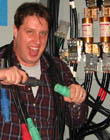|
|
This topic comprises 3 pages: 1 2 3
|
|
Author
|
Topic: How does power supply regulate amperage
|
|
|
|
|
|
|
|
|
John Hawkinson
Film God

Posts: 2273
From: Cambridge, MA, USA
Registered: Feb 2002
|
 posted 12-26-2009 09:25 AM
posted 12-26-2009 09:25 AM




Err...voltage and current are inexorably linked. You can't really change one without the other changing.
When we say "Xenon lamps are current-controlled" what we really mean is that there is a very small voltage variation for a rather large current variation. Change the voltage by a little, and the current can change a lot. Change the current by a little, and the voltage change is almost imperceptible.
So really it comes down to how you think about it. You can think about the rectifier changing its output voltage to change the lamp's applied current. This tends to make sense to me, but it's not the only legitimate interpretation.
It is true that you can't really think about the current without knowing the characteristics of the load (the lamp), whereas its easy to think about the voltage without the load. But of course, the load characteristics of the lamp are radically different before and after striking...
Monte, switching power supplies do not switch at 60 Hz. They switch a thousand times faster (in the kHz), and then that switched voltage is filtered to look like smooth DC, but there is always some ripple (just as there is with traditional high-reactance power supplies).
--jhawk
| IP: Logged
|
|
Randy Stankey
Film God

Posts: 6539
From: Erie, Pennsylvania
Registered: Jun 99
|
 posted 12-26-2009 10:08 AM
posted 12-26-2009 10:08 AM




Generally speaking... If you are talking about electricity going through a transformer, changing the ratio of primary windings to secondary windings (AKA: "Taps") will vary the voltage coming out of the secondary, assuming the voltage going into the primary is constant. Current generally obeys Ohm's Law.
Now, if you have a regulated power supply there are many kinds of components which can be used to ensure the output stays within a certain range, it is possible to regulate current. Some of those power supplies can be very complicated.
When a power supply is built, regardless of the type, it will engineered from the ground up to supply voltage and current within certain ranges. Therefore, in operation, resetting the taps will vary the voltage and the current according to the laws of physics/electronics but, if the device is operating the way it is supposed to, you should not see current or voltage go outside the limits that the xenon lamp can handle.
| IP: Logged
|
|
|
|
|
|
John Hawkinson
Film God

Posts: 2273
From: Cambridge, MA, USA
Registered: Feb 2002
|
 posted 12-26-2009 10:29 AM
posted 12-26-2009 10:29 AM




Louis, why is a display of watts useful?
A reasonably wide display of voltage is helpful in diagnosing striking problems (is the no-load voltage sufficient to strike?) and once you've struck, as long as the voltage is near the nominal operating point (e.g. 28V for a 2k), it's not very interesting.
Current is what the bulb is actually rated in, and is what matters for ohmic heating of components (I^2*R) and I think is also what the luminous flux is proportional to. It's what the bulb datasheet rates the bulb in terms of.
As the bulb ages, the cathode tip erodes (from striking), and that causes the operating voltage of the lamp to rise. If you maintained constant-current as this happened, then the power draw (watts) of the bulb would grow without the brightness growing. (Of course, that's not what actually happens. Since the rectifier probably tends to maintain constant-wattage output, meaning as the bulb's required voltage increases its current draw changes and it's necessary to adjust the rectifier's current control to get the same current through the bulb...; and of course there's also the fact that the same current will produce lower brightness from a bulb as it ages...blackening? not sure what the mechanisms there are...)
So why do you want watts? Sure, it's the product of volts*amps, but if, e.g, your voltage is at 28.0V and you are running at 80A, that's 2240W, but still perfectly OK on a 2k bulb. And if your voltage rises to 30.0V and you're still at 80A, that's 2400W, but it's still within the current-control range of the bulb. On the other hand, if your current rose to 85A (the maximum by the datasheet) and your voltage was still at 28V, then your power would be 2380W, but you would *not* be ok (redlining the bulb). So 2400W could reflect a reasonable current with a high-but-acceptable voltage, which is fine. But it could also by a normal voltage with a too-high current, which is not fine.
I guess cooling capacity of the lamphouse is measured in watts, but one would think that a reasonably-designed lamphouse would deal adequately with the full range of a 2k lamp (famous last words...)
--jhawk
| IP: Logged
|
|
|
|
|
|
|
|
|
|
|
|
|
|
|
|
All times are Central (GMT -6:00)
|
This topic comprises 3 pages: 1 2 3
|
Powered by Infopop Corporation
UBB.classicTM
6.3.1.2
The Film-Tech Forums are designed for various members related to the cinema industry to express their opinions, viewpoints and testimonials on various products, services and events based upon speculation, personal knowledge and factual information through use, therefore all views represented here allow no liability upon the publishers of this web site and the owners of said views assume no liability for any ill will resulting from these postings. The posts made here are for educational as well as entertainment purposes and as such anyone viewing this portion of the website must accept these views as statements of the author of that opinion
and agrees to release the authors from any and all liability.
|

 Home
Home
 Products
Products
 Store
Store
 Forum
Forum
 Warehouse
Warehouse
 Contact Us
Contact Us




 Printer-friendly view of this topic
Printer-friendly view of this topic















